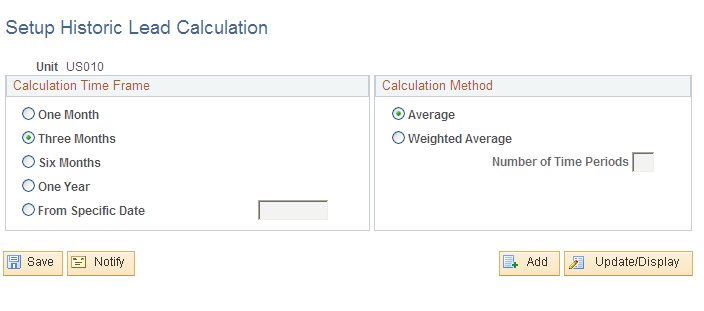Making Historical Lead Calculations
To set up historical lead calculation methods, use the Setup Historic Lead Calc (HIST_LD_SETUP_INV) component.
|
Page Name |
Definition Name |
Usage |
|---|---|---|
|
HIST_LD_SETUP_INV |
Define historical lead calculations based on various time frames and methods. |
|
|
Calculate Historic Lead Time Page |
HIST_LD_REQ_INV |
Define parameters for the Calculate Historic Lead Time process (IN_HIST_LEAD) by selecting . |
|
FULFILL_ATTRIB_INV |
Review the historic lead times calculated by the Calculate Historic Lead Time process and update the projected lead time of an item. |
To define historical lead time calculation parameters, use the Historical Lead Calc Setup (HIST_LD_SETUP_INV) component.
Use the Setup Historic Lead Calculation page (HIST_LD_SETUP_INV) to define historical lead calculations based on various time frames and methods.
Navigation:
This example illustrates the fields and controls on the Setup Historic Lead Calculation page. You can find definitions for the fields and controls later on this page.

Each shipment has a lead time that is equal to the number of days between the demand date and the shipment date. The demand date is the date the material stock request or sales order was sent to PeopleSoft Inventory to begin the fulfillment process; the ship date is the date the material stock request or sales order demand line was shipped.
Field or Control |
Description |
|---|---|
Calculation Time Frame |
Determines the period of time to include in the calculation. |
Average |
Calculates the historic lead time by summing the individual lead times and dividing the result by the number of shipments. |
Weighted Average |
Calculates the historic lead time by dividing the specified calculation time frame into the number of time periods. The lead time for shipments that fall within a more recent time period are weighted more heavily than those in an earlier time period. For example, if you specified three months as the time frame and three as the number of time periods, each time period is approximately one month. The lead time for shipments that fall in the earliest period have a weight of one, those that fall in the middle period have a weight of two, and those in the most recent period have a weight of three. The historical lead for the item is skewed toward the more recent shipments. Weighted average calculation can provide a more accurate picture of historical lead. |
Use the Shipping Lead Time page (FULFILL_ATTRIB_INV) to review the historic lead times calculated by the Calculate Historic Lead Time process and update the projected lead time of an item.
Navigation:
This example illustrates the fields and controls on the Shipping Lead Time page. You can find definitions for the fields and controls later on this page.

The result of the Calculate Historic Lead Time process appears in the Historical Lead Days field. Enter or update the Projected Lead Days field. This information is for reporting and inquiry purposes only.